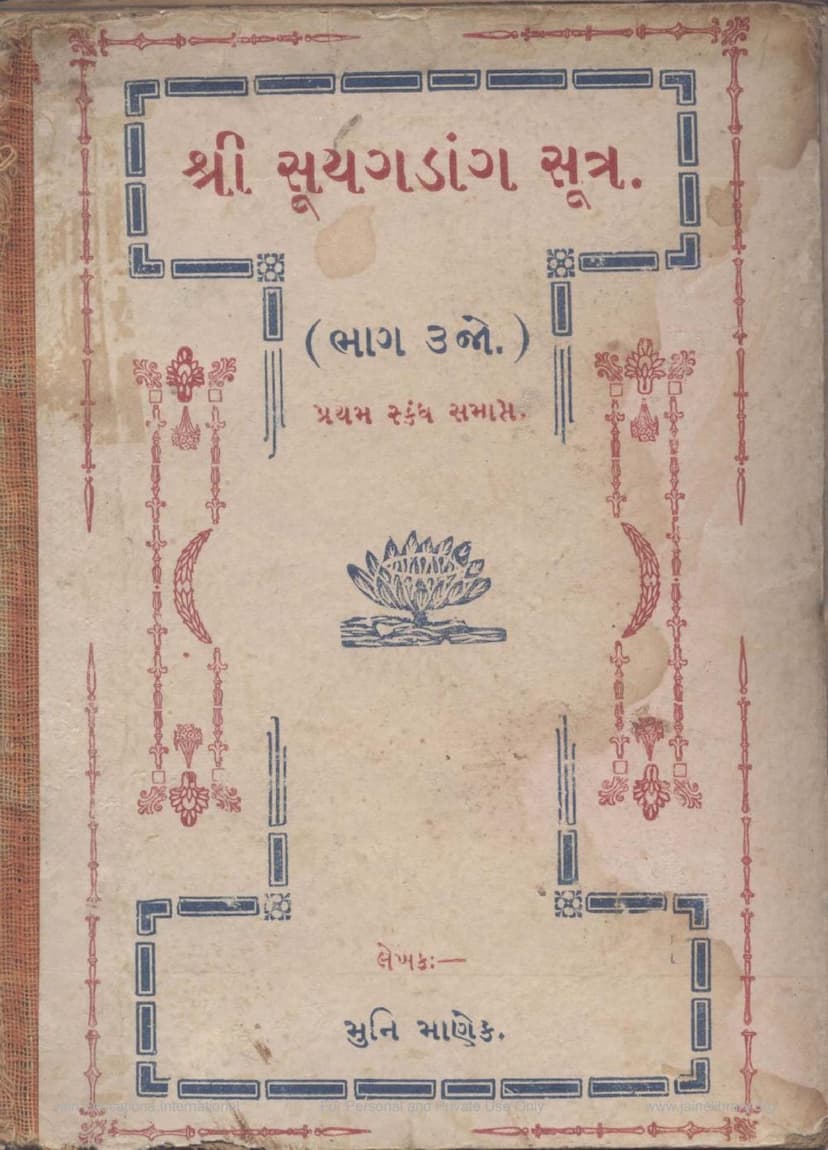Agam 02 Ang 02 Sutrakrutang Sutra Part 03
Added to library: September 1, 2025

Summary
Here's a comprehensive summary in English of the provided Jain text, "Agam 02 Ang 02 Sutrakrutang Sutra Part 03," authored by Muni Manekmuni, published by Shree Shanatlalji Jain Shwetambar Gyanbhandar, Surat, in Samvat 1987 (1931 CE).
This text is the third part of the Sutrakrutang Sutra, a significant Jain scripture. It focuses on the commentary, Mula Sutra, and Niyukti for Chapters 8 through 16 of the Sutrakrutang Sutra. The author, Muni Manekmuni, explains that this third part is being published due to a lack of sufficient demand for the first part, which covered seven chapters.
The book aims to provide a Gujarati translation of the difficult commentary, making the profound meanings accessible to a wider audience, particularly lay followers (Shravakas). The author notes that while alone Sutra translations are available and popular among Sthanakavasi Jains, the commentary is mainly read by Murti-puja followers. He expresses hope that this translation will lead to the publication of the remaining commentary.
Key themes and summaries of the chapters covered in this volume (Chapters 8-16):
-
Chapter 8: Virya (Strength/Energy): This chapter emphasizes the importance of physical and mental strength (Virya) for adhering to pure conduct. It differentiates between the strength used for practicing asceticism (Pandit Virya), the strength of householders (Bal Pandit Virya), and the strength misused in sinful activities (Bal Virya). The core message is to avoid the misuse of strength and energy. It delves into the concepts of Nichepa, Niyukti, and the various types of energy (Virya) derived from the soul's inherent power. It discusses the strength of animate and inanimate objects, the effects of food, medicine, and the importance of using one's energy wisely for spiritual pursuits rather than worldly activities.
-
Chapter 9: Dharma (Religion/Righteousness): This chapter explains that the true essence of Dharma lies in the proper utilization of one's strength (Virya). It highlights the need for constant pursuit of knowledge and austerity, urging ascetics not to be proud of their practices but to strive for liberation (Moksha). The chapter reiterates the principles of Dharma outlined in the Dashavaikalik Sutra, emphasizing that right conduct is the true Dharma.
-
Chapter 10: Samadhi (Equanimity/Concentration): This chapter stresses the importance of achieving equanimity in spiritual practice. It states that true Dharma practitioners should not be swayed by attachment or aversion but should focus on their pure soul-state. The text advises abandoning material possessions (Parigraha) as they increase attachment and aversion. It also emphasizes not harboring desires for life or death but maintaining a balanced state of mind.
-
Chapter 11: Marga (Path): This chapter defines the path to liberation as knowledge, perception, and conduct (Jnana, Darshan, Charitra). It explains the path shown by the Tirthankaras and advises controlling the mind and senses to follow the path of pure restraint.
-
Chapter 12: Samavsaran: This chapter describes the assembly where the Tirthankaras deliver discourses. It mentions the gathering of diverse individuals, including those with different philosophical viewpoints (363 views), and discusses the characteristics of believers (Astika) and non-believers (Nastika). The chapter also advises ascetics to remain detached from sensory experiences like sound, touch, taste, smell, and form to achieve liberation.
-
Chapter 13: Yathatathya (Truthfulness/As it is): This chapter emphasizes the importance of speaking the truth clearly and adhering to it. It also stresses the need to avoid causing distress to others.
-
Chapter 14: Granth (Scripture/Book): This chapter focuses on the internal state of an ascetic. It advises against harboring inner "wealth" like anger and other negative emotions. It states that only those ascetics who study scriptures and practice austerity are fit to guide others towards equanimity.
-
Chapter 15: Adan (Acquisition/Acceptance): This chapter highlights the importance of acquiring the soul's qualities like knowledge, perception, and conduct (Jnana, Darshan, Charitra). By accepting these, one can attain liberation or become a celestial being.
-
Chapter 16: Gatha (Verse/Summary): This final chapter summarizes the essence of the preceding fifteen chapters. It elaborates on the characteristics of Brahmins, Shramanas, Bhikshus, and Nirgranthas, presenting them in a clear and insightful manner.
The author concludes by stating that while the primary audience is ascetics (monks and nuns), householders who read this will also benefit greatly. He reiterates that the third part serves as a guide for well-being. The book also acknowledges the financial contributions of literature enthusiasts like Shree Jhaveri Maganbhai Nginbhai and Shree Jhaveri Jivanbhai Sakarchand, whose support was crucial for publishing these works. The author expresses a humble request for continued support to publish more valuable texts from the Gyanbhandar.
The publication also includes a brief mention of the beautiful 21-spired Jain temple in Surat built by Seth Bhaidas Durlabhdas and his wife Lakshmibai, highlighting their devotion and contributions to Jain heritage.
In essence, this volume of Sutrakrutang Sutra, particularly Part 3, is a detailed exposition of the path to spiritual liberation, emphasizing the importance of inner strength, true righteousness, equanimity, knowledge, conduct, and detachment from worldly possessions and desires, all explained through the lens of Muni Manekmuni's insightful commentary.